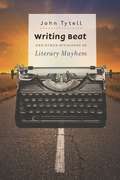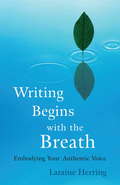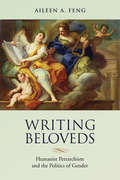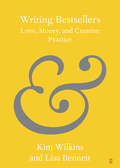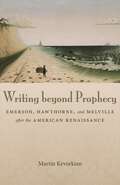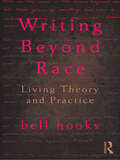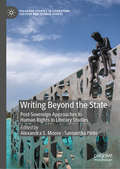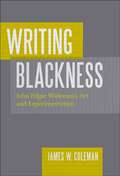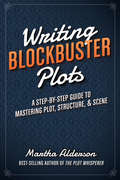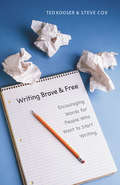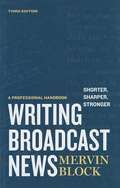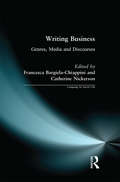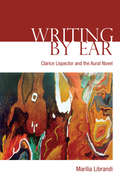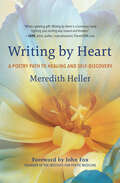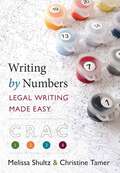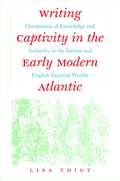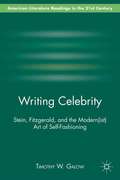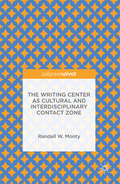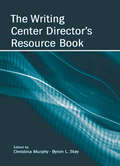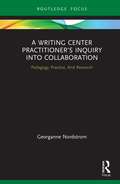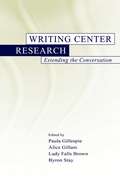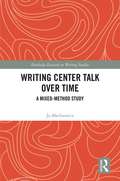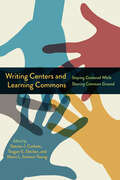- Table View
- List View
Writing Beat and Other Occasions of Literary Mayhem
by John TytellThe story and history of the Beats couldn't be found in the traditional libraries or archives of academic research. For preeminent historian of Beat culture John Tytell, it had to be found in the bars, towns, roads, and hangouts of these writers and figures. And as Writing Beat demonstrates, the same techniques apply to new and future writers.Approaching the history of post-war twentieth century American literature, and in particular the Beat literary movement of Kerouac, Ginsberg, Burroughs, and others, Tytell finds himself uniquely positioned as an eyewitness to many of these stories. In this book, he shares his insight with the reader. As he interviewed, drank, traveled, and survived countless moments with some of these literary legends, Tytell discovered much about the craft of nonfiction, biography, and the nature of history. Writing Beat demonstrates, through Tytell's growth as a professor and historian of the Beats, lessons learned and hazards encountered for those aspiring to become writers themselves.As we approach the sixtieth anniversary of Allen Ginsberg's Howl, Writing Beat reminds us writers do not spring to life fully formed, and the struggle to get to literature can be a blast.
Writing Beat and Other Occasions of Literary Mayhem
by John TytellThe story and history of the Beats couldn't be found in the traditional libraries or archives of academic research. For preeminent historian of Beat culture John Tytell, it had to be found in the bars, towns, roads, and hangouts of these writers and figures. And as Writing Beat demonstrates, the same techniques apply to new and future writers. Approaching the history of postwar twentieth-century American literature, and in particular the Beat literary movement of Kerouac, Ginsberg, Burroughs, and others, Tytell finds himself uniquely positioned as an eyewitness to many of these stories. In this book, he shares his insight with the reader. As he interviewed, drank, traveled, and survived countless moments with some of these literary legends, Tytell discovered much about the craft of nonfiction and biography, and the nature of history. Writing Beat demonstrates, through Tytell's growth as a professor and historian of the Beats, lessons learned and hazards encountered for those aspiring to become writers themselves. As we approach the sixtieth anniversary of Allen Ginsberg's Howl, Writing Beat reminds us writers do not spring to life fully formed, and the struggle to get to literature can be a blast.
Writing Begins with the Breath: Embodying Authentic Voice
by Laraine HerringIn this distinctive guide to the craft of writing, author Laraine Herring shows us how to tune into our bodies and connect with our emotions so that our writing becomes an expression of our full beings, rather than just an intellectual exercise. With warmth and wisdom, Herring offers a path to discovering "deep writing"--prose that is unique, expressive, and profoundly authentic. Lessons and imaginative exercises show you how to: stay with your writing when your mind or body starts to pull you away; explore the five senses in your writing; and approach your writing without judgment.Writing Begins with the Breath will open up a whole world of creativity for people who may not have considered themselves writers before, while also providing keen insights into the craft for seasoned writers.To learn more about the author, Laraine Herring, visit her website at www.laraineherring.com.
Writing Beloveds: Humanist Petrarchism and the Politics of Gender
by Aileen FengCovering a period from the late-fourteenth to mid-sixteenth century, Aileen A. Feng’s engagingly written work identifies and analyzes a Latin humanist precursor to the poetic movement known as Renaissance Petrarchism. Though Petrachism is usually read solely as a vernacular poetic tradition, in Writing Beloveds, Feng recovers the initial political purposes in Latin prose and traces how poetry set the terms for gender, agency, and power in early modern Italy. By revealing the literary motifs in men’s and women’s writing about gender she maps how certain figures in Petrarch’s writing transmitted gendered ideas of power and reflected a growing anxiety about women as public figures. This work includes nuanced analyses of poetry, linguistic treatises, debates on imitation, representations of gender and epistolary correspondence in Latin and Italian. Writing Beloveds is a landmark study that highlights the new social reality of women writers in early modern Europe.
Writing Bestsellers: Love, Money and Creative Practice (Elements in Publishing and Book Culture)
by Kim Wilkins Lisa BennettWhile the term 'bestseller' explicitly relates books to sales, commercially successful books are also products of individual creative work. This Element presents a new perspective on the relationship between art and the market, with particular reference to bestselling writers and books. We examine some existing perspectives on art's relationship to the marketplace to trouble persistent binaries that see the two in opposition; we break down the monolith of the marketplace by thinking of it as made up of a range of invested, non-hostile participants such as publishing personnel and readers; we articulate the material dimensions of creative writing in the industry through the words of bestselling writers themselves; and we examine how the existence of bestselling books and writers in the world of letters bears enormous influence on the industry, and on the practice of other writers.
Writing beyond Prophecy: Emerson, Hawthorne, and Melville after the American Renaissance
by Martin KevorkianWriting beyond Prophecy offers a new interpretation of the American Renaissance by drawing attention to a cluster of later, rarely studied works by Ralph Waldo Emerson, Nathaniel Hawthorne, and Herman Melville. Identifying a line of writing from Emerson's Conduct of Life to Hawthorne's posthumously published Elixir of Life manuscript to Melville's Clarel: A Poem and Pilgrimage in the Holy Land, Martin Kevorkian demonstrates how these authors wrestled with their vocational calling. Early in their careers, these three authors positioned their literary pursuits as an alternative to the ministry. By presenting a "new revelation" and a new set of "gospels" for the nineteenth century, they sought to usurp the authority of the pulpit. Later in life, each writer came to recognize the audacity of his earlier work, creating what Kevorkian characterizes as a literary aftermath. Strikingly, each author later wrote about the character of a young divinity student torn by a crisis of faith and vocation. Writing beyond Prophecy gives a distinctive shape to the late careers of Emerson, Hawthorne, and Melville and offers a cohesive account of the lingering religious devotion left in the wake of American Romanticism.
Writing Beyond Race: Living Theory and Practice
by bell hooksWhat are the conditions needed for our nation to bridge cultural and racial divides? By "writing beyond race," noted cultural critic bell hooks models the constructive ways scholars, activists, and readers can challenge and change systems of domination. In the spirit of previous classics like Outlaw Culture and Reel to Real, this new collection of compelling essays interrogates contemporary cultural notions of race, gender, and class. From the films Precious and Crash to recent biographies of Malcolm X and Henrietta Lacks, hooks offers provocative insights into the way race is being talked about in this "post-racial" era.
Writing Beyond the State: Post-Sovereign Approaches to Human Rights in Literary Studies (Palgrave Studies in Literature, Culture and Human Rights)
by Samantha Pinto Alexandra S. MooreThis book investigates the imaginative capacities of literature, art and culture as sites for reimagining human rights, addressing deep historical and structural forms of belonging and unbelonging; the rise of xenophobia, neoliberal governance, and securitization that result in the purposeful precaritization of marginalized populations; ecological damage that threatens us all, yet the burdens of which are distributed unequally; and the possibility of decolonial and posthuman approaches to rights discourses. The book starts from the premise that there are deep-seated limits to the political possibilities of state and individual sovereignty in terms of protecting human rights around the world. The essays explore how different forms, materials, perspectives, and aesthetics can help reveal the limits of normative human rights and contribute to the cultural production of new human rights imaginaries beyond the borders of state and self.
Writing Biography in Greece and Rome:
by De Temmerman, Koen and Demoen, Kristoffel Koen De Temmerman Kristoffel DemoenAncient biography is now a well-established and popular field of study among classicists as well as many scholars of literature and history more generally. In particular biographies offer important insights into the dynamics underlying ancient performance of the self and social behaviour, issues currently of crucial importance in classical studies. They also raise complex issues of narrativity and fictionalization. This volume examines a range of ancient texts which are or purport to be biographical and explores how formal narrative categories such as time, space and character are constructed and how they address (highlight, question, thematize, underscore or problematize) the borderline between historicity and fictionality. In doing so, it makes a major contribution not only to the study of ancient biographical writing but also to broader narratological approaches to ancient texts.
Writing Blackness: John Edgar Wideman's Art and Experimentation
by James W. ColemanOne of the most critically acclaimed yet least recognized contemporary writers, African American author John Edgar Wideman creates work often described as difficult, even unfathomable. In Writing Blackness, James Coleman examines Wideman's prolific body of work with the goal of making his often elusive imagery and dense style more accessible and thus broadening his readership. <P><P>More so than for most writers, Coleman shows, Wideman's life has affected his writing. Born in 1941, Wideman grew up in a Pittsburgh suburb where he attended an integrated high school, starred on the basketball team, and was senior class president and valedictorian. At the University of Pennsylvania he studied creative writing and became an all--Ivy League basketball player. Winning a Rhodes scholarship, he studied at Oxford, after which he returned to Penn and became its first black tenured professor. <P><P>Wideman published his first novel, A Glance Away, at age twenty-six and by 1973 had published two more works of fiction. But for all this success, something began to wear on him. In 1973, his grandmother died, and after listening to family stories when he traveled home for the funeral, Wideman began to change his world view. <P><P>Between 1973 and 1981 Wideman published nothing and immersed himself in African American culture, reading widely and -- even more important -- moving much closer to his family. Since 1981, Wideman has refocused his life and writing on blackness and published twelve experimental works, all very different from his earlier books. Coleman examines nearly all of Wideman's work, from A Glance Away (1967) to Fanon (2008). <P><P>He shows how Wideman has developed a unique style that combines elements of fiction, biography, memoir, history, legend, folklore, waking life, and dream in innovative ways in an effort to grasp the meaning of blackness -- an effort that makes his writing challenging but that holds more than ample rewards for the perceptive reader. In Writing Blackness, Coleman demonstrates why Wideman ranks among the best of contemporary American writers.
Writing Blockbuster Plots: A Step-by-Step Guide to Mastering Plot, Structure, and Scene
by Martha AldersonPlotting a story filled with memorable, engaging scenes from beginning to end can feel like an insurmountable challenge. Having the right plan - and the tools to execute it - can make all the difference. Writing Blockbuster Plots pulls back the curtain on story structure with step-by-step strategies and visuals that turn plotting and scene writing into a no-stress endeavor.In this completely revised and updated edition, celebrated writing instructor and plot consultant Martha Alderson helps you navigate the intricacies of story with the help of her exclusive Plot Planner and Scene Tracker tools. Using Alderson's effective, accessible techniques, you'll be able to:PLOT your story from beginning to end with a focus on dramatic action, the emotional development of your characters, and thematic significance.ENSURE that each scene contributes meaningfully to the narrative by tracking the seven essential elements of scene.LINK scenes by cause and effect to create a tight, seamless narrative.INJECT tension and conflict to keep readers glued to the page.TARGET weak areas in your story and learn how to fix them.Filled with examples from both classic and contemporary novels, as well as illustrations of the Plot Planner and Scene Tracker in action, Writing Blockbuster Plots strips the confusion out of the plotting process, enabling you to write a story that deserves a standing ovation.
Writing Brave and Free: Encouraging Words for People Who Want to Start Writing
by Ted Kooser Steve CoxSometimes setting pen to paper requires bravery, and writing well means breaking free of the rules learned in school. Liberating and emboldening the beginning writer are the goals of Ted Kooser and Steve Cox in this spirited book of practical wisdom that brings to bear decades of invaluable experience in writing, teaching, editing, and publishing. Unlike “how to write” books that dwell on the angst and the agony of the trade, Writing Brave and Free is upbeat and accessible. The focus here is the work itself: how to get started and how to keep going, and never is heard a discouraging word such as “no,” “not,” or “never.” Because of the wealth of their experience, the authors can offer the sort of practical publishing advice that novices need and yet rarely find. Organized in brief, user-friendly chapters—on everything from sensory details to a work environment, from creating suspense to revising and taking criticism—the book allows aspiring (and practicing) writers to dip in anywhere and find something of value.
Writing Broadcast News: Shorter, Sharper, Stronger
by Mervin BlockMervin Block- who has written for the best in the business- offers timeless advice, guiding both first-year students and seasoned professionals through the essentials of writing for the ear. With countless scripts collected from writing workshops in newsrooms across the country, this resource is studded with insightful- and at times entertaining- comments, suggestions and much-needed corrections. Readers will find Block's clear and incisive voice coming through in the expanded "Top Tips of the Trade" and the "Dozen Deadly Sins"—reminding us that mistakes can be our best teachers. New "WordWatcher" boxes highlight the challenges in writing for print versus broadcast.
Writing Business: Genres, Media and Discourses (Language In Social Life)
by Francesca Bargiela-Chiappini Catherine Ross NickersonWriting Business: Genres, Media and Discourses offers an analysis of the genres and functions of written discourse in the business context, involving a variety of modes of communication. The evolution of new forms of writing is a key focus of this collection and is only partly attributable to the ever increasing application of technology at work. Alongside machine-mediated texts such as electronic mail and computer-generated correspondence, the contextualised analyses of both traditional genres such as facsimiles and direct mailing, and of lesser studied texts such as invitations for bids, contracts, business magazines and ceremonial speeches, reveal a rich complexity in the forms of communication evolved by organisations and the individuals who work within them, in response to the demands of the social, organisational and cultural contexts in which they operate. This rich textual variation is matched by a discussion of a range of methodological approaches to the development of business writing skills, including rhetorical analysis, organisational communication analysis, social constructionism, genre analysis and survey and experimental methods. Using authentic data and benefiting from a fresh, interdisciplinary approach, the volume will be of interest to students and researchers of business communication, Language for Specific Purposes (LSP), English for Specific Purposes (ESP), and sociolinguistics.
Writing by Ear: Clarice Lispector and the Aural Novel (University of Toronto Romance Series)
by Marilia LibrandiConsidering Brazilian novelist Clarice Lispector’s literature as a case study and a source of theory, Writing by Ear presents an aural theory of the novel based on readings of Near to the Wild Heart (1943), The Besieged City (1949), The Passion According to G.H. (1964), Agua Viva (1973), The Hour of the Star (1977), and A Breath of Life (1978). What is the specific aesthetic for which listening-in-writing calls? What is the relation that listening-in-writing establishes with silence, echo, and the sounds of the world? How are we to understand authorship when writers present themselves as objects of reception rather than subjects of production? In which ways does the robust oral and aural culture of Brazil shape literary genres and forms? In addressing these questions, Writing by Ear works in dialogue with philosophy, psychoanalysis, and sound studies to contemplate the relationship between orality and writing. Citing writers such as Machado de Assis, Oswald de Andrade and João Guimarães Rosa, as well as Mia Couto and Toni Morrison, Writing By Ear opens up a broader dialogue on listening and literature, considering the aesthetic, ethical, and ecological reverberations of the imaginary. Writing by Ear is concerned at once with shedding light on the narrative representation of listening and with a broader reconceptualization of fiction through listening, considering it an auditory practice that transcends the dichotomy of speech and writing.
Writing by Heart: A Poetry Path to Healing and Self-Discovery
by Meredith HellerWrite to Explore and Express the Wild Beauty of Your Heart Meredith Heller invites you to write as a path toward self-understanding and as a lifelong refuge of steadfast friendship with yourself. She used the power of writing to heal and save her own life, and now she teaches others to do the same. In this book, Meredith shares the techniques she developed to help people from all walks of life explore their emotions, find their voice, and better navigate life’s challenges. Filled with potent exercises and inspiring poems from the author and her students, Writing by Heart is a must-read for anyone, from seasoned writer to novice, who wants to discover the transformative power of writing.
Writing By Numbers: Legal Writing Made Easy
by Melissa Shultz Christine TamerGiven the reality that legal writing is difficult for most new law students, Writing by Numbers: Legal Writing Made Easy aims to demystify the writing process by providing concrete formulas for mastering objective and persuasive legal writing. Put simply, at each juncture of your journey to become a proficient legal writer, this book gives you a roadmap to follow, broadly starting with the macro-formula CRAC (Conclusion, Rule, Analysis, and Conclusion) and then moving to micro-formulas for each part of the macro formula. The goal is that you will never find yourself lost―that is, you will never find yourself facing an entirely blank page without direction.
Writing Captivity in the Early Modern Atlantic
by Lisa VoigtDrawing on texts written by and about European and Euro-American captives in a variety of languages and genres, Lisa Voigt explores the role of captivity in the production of knowledge, identity, and authority in the early modern imperial world. The practice of captivity attests to the violence that infused relations between peoples of different faiths and cultures in an age of extraordinary religious divisiveness and imperial ambitions. But as Voigt demonstrates, tales of Christian captives among Muslims, Amerindians, and hostile European nations were not only exploited in order to emphasize cultural oppositions and geopolitical hostilities. Voigt's examination of Spanish, Portuguese, and English texts reveals another early modern discourse about captivity--one that valorized the knowledge and mediating abilities acquired by captives through cross-cultural experience. Voigt demonstrates how the flexible identities of captives complicate clear-cut national, colonial, and religious distinctions. Using fictional and nonfictional, canonical and little-known works about captivity in Europe, North Africa, and the Americas, Voigt exposes the circulation of texts, discourses, and peoples across cultural borders and in both directions across the Atlantic.
Writing Celebrity
by Timothy W. GalowWriting Celebrity is divided into three major sections. The first part traces the rise of a national celebrity culture in the United States and examines the impact that this culture had on "literary" writing in the decades before World War II. The second two sections of the book demonstrate the relevance of celebrity for literary scholarship by re-evaluating the careers of two major American authors, F. Scott Fitzgerald and Gertrude Stein.
The Writing Center as Cultural and Interdisciplinary Contact Zone
by Randall W. MontyWriting centers are complex. They are places of scholarly work, spaces of interdisciplinary interaction, and programs of service, among other things. With this complexity in mind, this book theorizes writing center studies as a function of its own rhetorical and discursive practices. In other words, the things we do and make define who we are and what we value. Through a comprehensive methodological framework grounded in critical discourse analysis, this book takes a closer look at prominent writing center discourses by temporarily shifting attention away from the stakeholders, work, locations, and scholarship of the discipline, and onto things--the artifacts and networks that make up the discipline. Through this approach, we can see the ways the discipline reinforces, challenges, reproduces, and subverts structures of institutional power. As a result, writing center studies can be seen a vast ecosystem of interconnectivity and intertextuality.
The Writing Center Director's Resource Book
by Christina Murphy Byron L. StayThe Writing Center Director's Resource Book has been developed to serve as a guide to writing center professionals in carrying out their various roles, duties, and responsibilities. It is a resource for those whose jobs not only encompass a wide range of tasks but also require a broad knowledge of multiple issues.The volume provides information on the most significant areas of writing center work that writing center professionals--both new and seasoned--are likely to encounter. It is structured for use in diverse institutional settings, providing both current knowledge as well as case studies of specific settings that represent the types of challenges and possible outcomes writing center professionals may experience. This blend of theory with actual practice provides a multi-dimensional view of writing center work.In the end, this book serves not only as a resource but also as a guide to future directions for the writing center, which will continue to evolve in response to a myriad of new challenges that will lie ahead.
A Writing Center Practitioner's Inquiry into Collaboration: Pedagogy, Practice, And Research (Routledge Research in Writing Studies)
by Georganne NordstromThis book presents a model of Practitioner Inquiry (PI) as a systematic form of empirical research and provides a rationale for its suitability within a writing center context. Exploring the potential of writing centers as pedagogical sites that support research, the book offers an accessible model that guides both research and practice for writing center practitioners, while offering flexibility to account for their distinct contexts of practice. Responding to the increasing call in the field to produce empirical “RAD” (replicable, aggregable, data-driven) research, the author explores Practitioner Inquiry through explication of methodology and methods, a revisitation of collaboration to guide both practice and research, and examples of application of the model. Nordstrom grounds this research and scholarship in Hawaiʻi’s context and explores Indigenous concepts and approaches to inform an ethical collaborative practice. Offering significant contributions to empirical research in the fields of writing center studies, composition, and education, this book will be of great relevance to writing center practitioners, anyone conducting empirical research, and researchers working in tutor professionalization, collaboration, translingual literacy practices, and researchmethodologies.
Writing Center Research: Extending the Conversation
by Paula Gillespie Alice Gillam Lady Falls Brown Byron StayThere are writing centers at almost every college and university in the United States, and there is an emerging body of professional discourse, research, and writing about them. The goal of this book is to open, formalize, and further the dialogue about research in and about writing centers. The original essays in this volume, all written by writing center researchers, directly address current concerns in several ways: they encourage studies, data collection, and publication by offering detailed, reflective accounts of research; they encourage a diversity of approaches by demonstrating a range of methodologies (e.g., ethnography, longitudinal case study; rhetorical analysis, teacher research) available to both veteran and novice writing center professionals; they advance an ongoing conversation about writing center research by explicitly addressing epistemological and ethical issues. The book aims to encourage and guide other researchers, while at the same time offering new knowledge that has resulted from the studies it analyzes.
Writing Center Talk over Time: A Mixed-Method Study (Routledge Research in Writing Studies)
by Jo MackiewiczIn the last 15 to 20 years, writing centers have placed greater importance on tutor training, focusing on teaching tutors best practices in fostering student writers’ engagement and writing skills. Writing Center Talk over Time explores the importance of writing center talk and demonstrates the efficacy of tutor training. The book uses corpus-driven analysis and discourse analysis to examine the changes in writing center talk over time to provide a baseline understanding of the very heart of writing center work: the talk that unfolds between tutors and student writers. It is this talk that, at its best, motivates student writers to continue to improve their writing and scaffolds their learning and that makes tutors proud of the service that they provide. The methods and analysis of this study are intended to inform other researchers so that they may conduct further research into the efficacy of writing center talk.
Writing Centers and Learning Commons: Staying Centered While Sharing Common Ground
by Steven J. Corbett Teagan E. Decker Maria L. L. Soriano YoungWriting Centers and Learning Commons presents program administrators, directors, staff, and tutors with theoretical rationales, experiential journeys, and go-to practical designs and strategies for the many questions involved when writing centers find themselves operating in shared environments. The chapters comprehensively examine the ways writing centers make the most of sharing common ground. Directors, coordinators, administrators, and stakeholders draw on past and present attention to writing center studies to help shape the future of the learning commons and narrate their substantial collective experience with collaborative efforts to stay centered while empowering colleagues and student writers at their institutions. The contributors explore what is gained and lost by affiliating writing centers with learning commons, how to create sound pedagogical foundations that include writing center philosophies, how writing center practices evolved or have been altered by learning center affiliations, and more. Writing Centers and Learning Commons is for all stakeholders of writing in and across campuses collaborating on (by choice or edict), or wishing to explore the possibilities of, a learning commons enterprise. Contributors: Alice Batt, Cassandra Book, Charles A. Braman, Elizabeth Busekrus Blackmon, Virginia Crank, Celeste Del Russo, Patricia Egbert, Christopher Giroux, Alexis Hart, Suzanne Julian, Kristen Miller, Robby Nadler, Michele Ostrow, Helen Raica-Klotz, Kathleen Richards, Robyn Rohde, Nathalie Singh-Corcoran, David Stock
